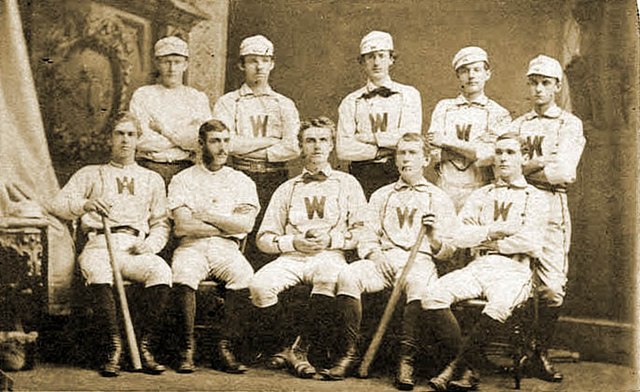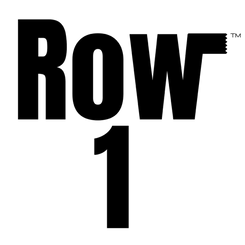The quest to learn more about sports history takes us to the 19th-Century baaseball doamons to tale a peak at what the players were wearing. Listen in to learn more about sports history along with me from the uniforms and jerseys the players wore.
History of 1800s Baseball Uniforms
How baseball player's shirts evolved in the 19th-century19th Century Baseball Jerseys
Baseball is truly an unique and an innovative sport. The game is so filled with numbers and statistics along with legendary athletes that have done remarkable things throughout the ages. This story of the professional player baseball jersey takes us to the New York Knickerbockers in a game they played on April 4, 1849. According to the Baseball Hall of Fame’s website,
“...the Knickerbocker Base Ball Club of New York City, was a simple outfit consisting of a white flannel shirt, blue wool pants, and a straw hat.”
During the 1850s, 1860s, and early 1870s the jersey itself was most famously a shield-front style. Interestingly enough they were greatly influenced by the same garb that local volunteer firemen of the era wore while on the job.

The shield-style uniforms are on full display in the above photo courtesy Wikimedia Commons. Pictured is the Washington & Jefferson College baseball team in 1870. While baseball as an organized official sport was instituted at W&J in 1867, little is known of its beginnings. The team pictured here is the first team to gain recognition representing W&J. It also played as a town team, the Red Stockings Baseball Club of Washington, Pennsylvania.
A new wave of shirts was ushered in during the mid-1870s, the laced jersey, although sporting goods supplier A.G. Spalding & Bros. had advertisements for their flannel “Fancy Shield Shirt” as late as 1893. Only a select few teams donned the front shield after 1875 though. The front-laced derivative of the uniform of the baseball diamond was in vogue for about a decade. The HOF claims that;
“Styles varied, with some shirts featuring lacing that ran the entire length of the shirt, while others had lacing for just the top portion of the jersey. Laced-front jerseys remained popular through the 1890s, but by 1901 only two of 16 major league clubs were wearing the style.”

The photo above demonstrates the laced up jerseys of the 1888 Syracuse University baseball team, taken by an unknown photographer, courtesy Wikimedia Commons.
Clowning Around
Baseball tried a very colorful experiment in 1882 when they had players of certain positions wear specially colored uniforms to denote their playing position. Yeah that’s right when your favorite team took the field in that era, none of the nine had the same shirt on! This experimental era of baseball jerseys are fondly referred to as the “Clown Costumes,” and rightfully so with the circus-look of the game. The Baseball Hall of Fame says this;
“Shortstops, for example, were required to wear maroon shirts and caps, while first basemen dressed like candy canes in scarlet-and-white-striped caps and jerseys.”
No hardball clown costume was complete until they also put on the mandatory white bowtie, white belt, and white trousers to complete the ensemble. The long highly worn socks or stockings were the only way anyone could denote which team the players were on. This is extremely interesting because the 1882 rule actually named some of the teams we know today. The rules makers said the Boston team had to wear Red Stockings and Chicago players were to wear only white ones, hence the nicknames of the Chicago White Sox and the Red Sox of Boston were inaugurated. There was much to say negatively about the clown costumes and there was so much bad publicity and confusion that the rule was thrown out midseason of 1882.

The above photo represents the famous "Clown Costume" edict of 1882 courtesy of Wikimedia Commons. It is a Digital scan of the 1882 Chicago White Stockings Team Photo with Fred Goldsmith (pitcher). Fred is in second row, and second man from right.
When the 20th-century arrived both the laced-front and the Front-shield shirts went out of style and a new generation of player gear emerged, the button-down shirts.
The buttoned apparel first made its way onto the diamond in the 1850s. They were not popular at first but after 1900 they dominated hardball teams around the country.

The Brooklyn Robins 1909 Checkerboard uniform worn by Gustave Getz. Getz was an American professional baseball third baseman. He played in Major League Baseball from 1909 through 1918 for the Boston Doves, Brooklyn Robins, Cincinnati Reds, Cleveland Indians, and Pittsburgh Pirates
One question on many fans of a certain New York team may be wondering, when did the era of the pinstripes come in? The Hall of Fame tells us that though multiple teams wore stripes in the past the true official pinstriped uniform was not seen until 1888. Washington and Detroit of the National League and Brooklyn of the American Association adorned themselves with the legendary jersey adornment that year. Brooklyn was the only one of the three original pinstripers to continue its use.They even modified the vertical stripes to add horizontal ones as well to become the first to wear a checkered pattern in 1889, and gues what? They won the pennant! We are not saying the checkerboard squares uniform shirt helped win a title, however when the Brooklyn club abandoned the fashion statement in 1890 they finished at the bottom of the League standings!
Photo Credits
Courtesy Wikimedia Commons. "Baseball Players Practicing," a watercolor, by the American artist Thomas Eakins. Courtesy of the Rhode Island School of Design Museum of Art.





